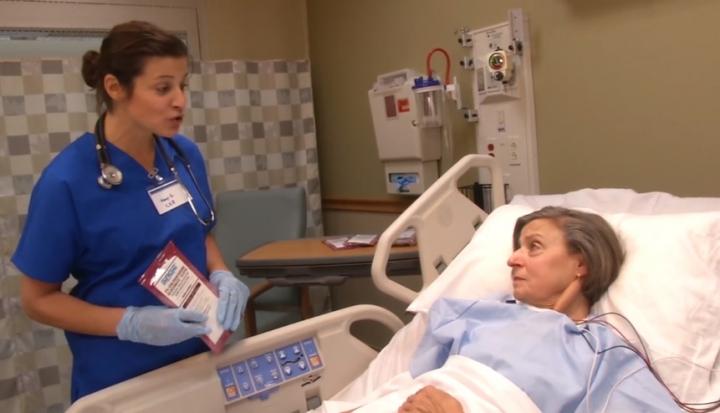NIH-sponsored ABATE study shows benefit for subset of hospitalized patients

Credit: NIH
New findings from a large, randomized clinical trial that compared two infection control techniques are already being incorporated into practice within the network of U.S. community hospitals where the trial took place. The trial evaluated whether daily bathing with the antiseptic soap chlorhexidine (CHG)–and in those patients with methicillin-resistant Staphylococcus aureus (MRSA), adding the nasal antibiotic mupirocin–more effectively reduced hospital-acquired bacterial infections than bathing with ordinary soap and water. While no statistically significant difference between the two intervention groups was seen within the population overall, the researchers did find that one subset of patients–those with medical devices–experienced a substantial benefit if they received the CHG/mupirocin intervention.
The ABATE (Active Bathing to Eliminate) Infection trial was initiated through the National Institutes of Health’s Common Fund program and was managed by the National Institute of Allergy and Infectious Diseases (NIAID), an NIH component. Results of the study, which involved about 330,000 adult patients in non-intensive care units in the HCA Healthcare system, appear today in The Lancet. Susan S. Huang, M.D., M.P.H., of the University of California Irvine School of Medicine, led the research team.
Previous clinical trials in intensive care units (ICUs) had shown that hospital-acquired infections could be dramatically reduced through such practices as CHG bathing, noted Dr. Huang. “Because there was a clear benefit with bacterial decolonization in the ICU setting, we pursued this trial to determine if similar interventions would reduce hospital-acquired infections in non-ICU settings, where the majority of such infections occur,” she said. Decolonization refers to the removal of skin-surface bacteria that are normally harmless, but that may enter the bloodstream following surgery or other procedures and cause infection, including life-threatening sepsis.
During a five-month recruitment period, 53 community hospitals (comprising 194 non-ICU units) throughout the HCA Healthcare system were randomized to either the routine bathing arm or the CHG bathing plus mupirocin arm of the study. Five hospitals withdrew, leaving 24 hospitals in each arm of the 21-month-long intervention. During that period, the 330,000 patients enrolled in the trial had 1.3 million days of hospital care.
The study was implemented as a quality improvement effort using staff and caregivers already working in the units. “We provided resources including coaching calls, training binders, and instructional handouts for patients and caregivers, as well as a training video with actors that demonstrated how caregivers might answer patient concerns about CHG bathing,” said Dr. Huang. Computer-based training was provided to 14,000 staff members in the participating hospitals. On request, trial team members visited sites to demonstrate CHG bathing techniques, but investigators were not on-site throughout the trial.
Within the overall study population, the research team found no statistically significant difference between the study arms. However, patients with medical devices, such as central venous catheters or lumbar drains, benefitted from the CHG/mupirocin intervention. Among that subset of patients, investigators recorded a 30 percent decrease in bloodstream infections and a nearly 40 percent decrease in antibiotic-resistant bacteria, including MRSA and vancomycin-resistant enterococcus, compared to rates seen in similar patients in the standard bathing arm of the trial. The benefit of CHG bathing for patients with devices is notable, said Dr. Huang. Although they represented only 12 percent of the total non-ICU patient population, patients with devices had a disproportionately high risk for bacterial infection: they accounted for 37 percent of MRSA and VRE clinical cultures and more than half of all bloodstream infections.
“The ABATE Infection trial is a good example of what a large-scale, pragmatic clinical trial can achieve within a relatively short period of time,” said NIAID Director Anthony S. Fauci, M.D. “This trial also highlights the value of partnerships between academic investigators and healthcare delivery organizations,” he said.
Classic clinical trials typically recruit and enroll patients one by one, and are often costly, labor-intensive and time-consuming. According to Dr. Huang, pragmatic trials complement the strengths of classic clinical trials, but because they are performed under ‘real world’ conditions–for example, by weaving quality improvement strategies into existing care routines–they are usually less expensive.
“The results of the ABATE Infection trial are already being incorporated into infection prevention efforts,” said Jonathan Perlin, M.D., Ph.D., chief medical officer of HCA Healthcare and a co-author of the new study. “The HCA system is using this decolonization strategy as a best practice for patients with medical devices across our 179 affiliated hospitals,” he said.
In addition to Dr. Huang and collaborators at the University of California Irvine, the study team included investigators from HCA Healthcare, Harvard Medical School and Harvard Pilgrim Health Care Institute, Rush Medical College and the Centers for Disease Control and Prevention. It was conducted as part of the NIH Collaboratory for pragmatic clinical trials to address questions of major public health importance. The antiseptic product was contributed by Sage Products and MoInlycke. The companies providing product to the trial had no role in the design, conduct, analysis or publication of the ABATE Infection trial.
###
Additional details about the ABATE Infection trial are available at ClinicalTrials.gov using the identifier NCT02063867.
The ABATE Infection trial was funded by NIH Common Fund grant UH2/UH3 AT007769-01 and by NIAID grant UH3AI113337.
Reference: SS Huang et al. Chlorhexidine versus routine bathing to prevent multidrug-resistant organisms and all-cause bloodstream infection in general medical and surgical units (ABATE Infection trial): a cluster-randomised trial. The Lancet DOI: 10.1016/ S0140-6736(18)32593-5 (2019).
NIAID conducts and supports research–at NIH, throughout the United States, and worldwide–to study the causes of infectious and immune-mediated diseases, and to develop better means of preventing, diagnosing and treating these illnesses. News releases, fact sheets and other NIAID-related materials are available on the NIAID website.
About the National Institutes of Health (NIH): NIH, the nation’s medical research agency, includes 27 Institutes and Centers and is a component of the U.S. Department of Health and Human Services. NIH is the primary federal agency conducting and supporting basic, clinical, and translational medical research, and is investigating the causes, treatments, and cures for both common and rare diseases. For more information about NIH and its programs, visit http://www.
Media Contact
Anne A. Oplinger
[email protected]
Related Journal Article
http://dx.





